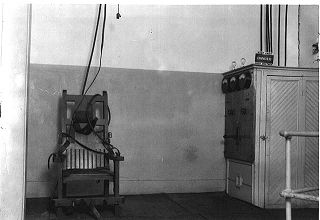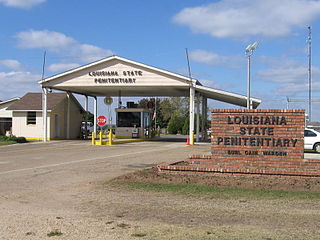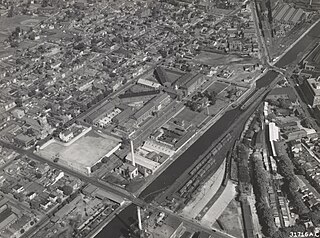This article needs additional citations for verification .(March 2011) |

Gruesome Gertie was the nickname given by death row inmates to the Louisiana electric chair.
Contents
It is also widely known for the failed execution of Willie Francis.
This article needs additional citations for verification .(March 2011) |

Gruesome Gertie was the nickname given by death row inmates to the Louisiana electric chair.
It is also widely known for the failed execution of Willie Francis.
The 1940 Louisiana legislature changed the method of execution, making execution by electrocution effective from June 1, 1941. Louisiana's electric chair did not have a permanent home at first, and was taken from parish to parish to perform the executions. The electrocution would usually be carried out in the courthouse or jail of the parish where the condemned inmate had been convicted. Eugene Johnson, a black man convicted of robbing and murdering Steven Bench, a white farmer who lived near Albany, was the first to die in Louisiana's electric chair; he was electrocuted in the Livingston Parish Jail on September 11, 1941.
In 1957, it was decided to build an execution chamber at the Louisiana State Penitentiary to carry out all executions in Louisiana. Notable executions in the chair were those of Elmo Patrick Sonnier (the inmate on whom the film Dead Man Walking was based) and Willie Francis (the only inmate to survive the electric chair; he was ultimately executed after the first attempt failed). Following new legislation enacted in 1991, the State of Louisiana opted for the use of lethal injection as the sole method of execution. The last person executed on "Gruesome Gertie" was Andrew Lee Jones, on July 22, 1991. During its fifty years, "Gruesome Gertie" was used for a total of 87 executions. It now sits at the Louisiana Prison Museum in Angola, Louisiana.
"Gruesome Gertie" is also infamous for having the first known incident of a failed execution by electrocution in the United States. During the execution of Willie Francis on May 3, 1946, the electric chair had been improperly set up by a drunken prison guard, causing Francis to scream "Take it off! Take it off! Let me breathe!" from behind his leather hood. [1] The execution was aborted, and an appeal was filed to the Supreme Court, which was denied. Francis was later successfully executed on May 9, 1947. [2]

The electric chair is a specialized device employed for carrying out capital punishment through the process of electrocution. During its use, the individual sentenced to death is securely strapped to a specially designed wooden chair and electrocuted via strategically positioned electrodes affixed to the head and leg. This method of execution was conceptualized by Alfred P. Southwick, a dentist based in Buffalo, New York, in 1881. Over the following decade, this execution technique was developed further, aiming to provide a more humane alternative to the conventional forms of execution, particularly hanging. The electric chair was first utilized in 1890 and subsequently became known as a symbol of this method of execution.

Capital punishment is a legal penalty in the U.S. state of Ohio, although all executions have been suspended indefinitely by Governor Mike DeWine until a replacement for lethal injection is chosen by the Ohio General Assembly. The last execution in the state was in July 2018, when Robert J. Van Hook was executed via lethal injection for murder.

Old Sparky is the nickname of the electric chairs in Arkansas, Connecticut, Florida, Georgia, Illinois, Kentucky, Nebraska, New York, Ohio, Oklahoma, South Carolina, Texas, Virginia, and West Virginia. Old Smokey was the nickname of the electric chairs used in New Jersey, Pennsylvania, and Tennessee. "Old Sparky" is sometimes used to refer to electric chairs in general, and not one of a specific state.

The Louisiana State Penitentiary is a maximum-security prison farm in Louisiana operated by the Louisiana Department of Public Safety & Corrections. It is named "Angola" after the former slave plantation that occupied this territory. The plantation was named after the country of Angola, from which many slaves originated before arriving in Louisiana.
Florida State Prison (FSP), otherwise known as Raiford Prison, is a correctional institution located in unincorporated Bradford County, Florida, with a Starke postal address. It was formerly known as the "Florida State Prison-East Unit" as it was originally part of Florida State Prison near Raiford. The facility, a part of the Florida Department of Corrections, is located on State Road 16 right across the border from Union County. The institution opened in 1961, even though construction was not completed until 1968. With a maximum population of over 1,400 inmates, FSP is one of the largest prisons in the state. FSP houses Florida's one of two male death row cell blocks and the State of Florida execution chamber. Union Correctional Institution also houses male death row inmates while Lowell Annex houses female death row inmates.
Yellow Mama is the electric chair of the U.S. state of Alabama. It was used for executions from 1927 to 2002.

Willie Francis was an American teenager known for surviving a failed execution by electrocution in the United States. He was a convicted juvenile sentenced to death at age 16 by the state of Louisiana in 1945 for the murder of Andrew Thomas, a pharmacy owner in St. Martinville who had once employed him. In the modern day, Francis's guilt has been disputed. He was 17 when he survived the first attempt to execute him, as the chair malfunctioned. After an appeal of his case taken to the Supreme Court of the United States failed, he was executed in 1947 at age 18.
The official title of "state electrician" was given to some American state executioners in states using the electric chair during the early 20th century, including the New York State electrician.
Elmo Patrick "Pat" Sonnier was a convicted American murderer and rapist in Louisiana who was executed by electrocution at Louisiana State Penitentiary in Louisiana on April 5, 1984. Sonnier was sentenced to death on April 25, 1978, for the November 5, 1977, rape and murder of Loretta Ann Bourque, 18, and the murder of David LeBlanc, 17. Sonnier's younger brother, Eddie, was sentenced to life in prison.

The New Jersey State Prison (NJSP), formerly known as Trenton State Prison, is a state men's prison in Trenton, New Jersey operated by the New Jersey Department of Corrections. It is the oldest prison in New Jersey and one of the oldest correctional facilities in the United States. It is the state's only completely maximum security institution, housing the most difficult and/or dangerous male offenders in the inmate population. NJSP operates two security units and provides a high level of custodial supervision and control. Professional treatment services, such as education and social work, are a priority at the facility. The Bureau of State Use Industries operated the bedding and clothing shops that were once located in Shop Hall at the facility. These industries have been relocated to South Woods State Prison.

Stateville Correctional Center (SCC) is a maximum security state prison for men in Crest Hill, Illinois, United States, near Chicago. It is a part of the Illinois Department of Corrections.

The Oklahoma State Penitentiary, nicknamed "Big Mac", is a prison of the Oklahoma Department of Corrections located in McAlester, Oklahoma, on 1,556 acres (6.30 km2). Opened in 1908 with 50 inmates in makeshift facilities, today the prison holds more than 750 male offenders, the vast majority of which are maximum-security inmates. They also hold many death row prisoners.

The State Correctional Institution – Rockview is a Pennsylvania Department of Corrections prison located in Benner Township, Pennsylvania, 5 miles (8.0 km) away from Bellefonte. A portion of the prison grounds extends into College Township.

The West Virginia Penitentiary is a gothic-style prison located in Moundsville, West Virginia. Now withdrawn and retired from prison use, it operated from 1866 to 1995. Currently, the site is maintained as a tourist attraction, museum, training facility, and filming location.
Glass v. Louisiana, 471 U.S. 1080 (1985), was a case denied for hearing by the United States Supreme Court in 1985. The case is famous for Justice Brennan's dissent from the denial of certiorari, joined by Justice Marshall, arguing that the death penalty is always unconstitutional.

Opened in 1969, Georgia Diagnostic and Classification Prison (GDCP) is a Georgia Department of Corrections prison for men in unincorporated Butts County, Georgia, near Jackson. The prison holds the state execution chamber. The execution equipment was moved to the prison in June 1980, with the first execution in the facility occurring on December 15, 1983. The prison houses the male death row, while female death row inmates reside in Arrendale State Prison.
Toni Jo Henry was the only woman ever to be executed in Louisiana's electric chair. Married to Claude 'Cowboy' Henry, she decided to break her husband out of jail where he was serving a fifty-year sentence in the Texas State Penitentiary for murder. Together with Harold Burks, she took a ride with Joseph P. Calloway, whom they then robbed and murdered. Toni Jo Henry was convicted and sentenced to death. After three trials, she was executed by electrocution on November 28, 1942. Her case generated several popular books and films including A Savage Wisdom and Stone Justice.

Capital punishment is a legal penalty in the U.S. state of Mississippi.

The Red Hat Cell Block is a former prison housing unit of the Louisiana State Penitentiary in West Feliciana Parish, Louisiana which, for a time, also contained the state's execution chamber and electric chair.

The South Carolina Penitentiary (SCP) (renamed the Central Correctional Institution (CCI) in 1965) was the state of South Carolina's first prison. Completed in 1867, the South Carolina Penitentiary served as the primary state prison for nearly 130 years until its demolition in 1999. It was located adjacent to the Congaree River in Columbia, South Carolina and was added to the National Register of Historic Places on January 4, 1996. It was replaced by the Lee Correctional Institution as the main prison in the state of South Carolina after the prison was deemed too overcrowded by a federal court.